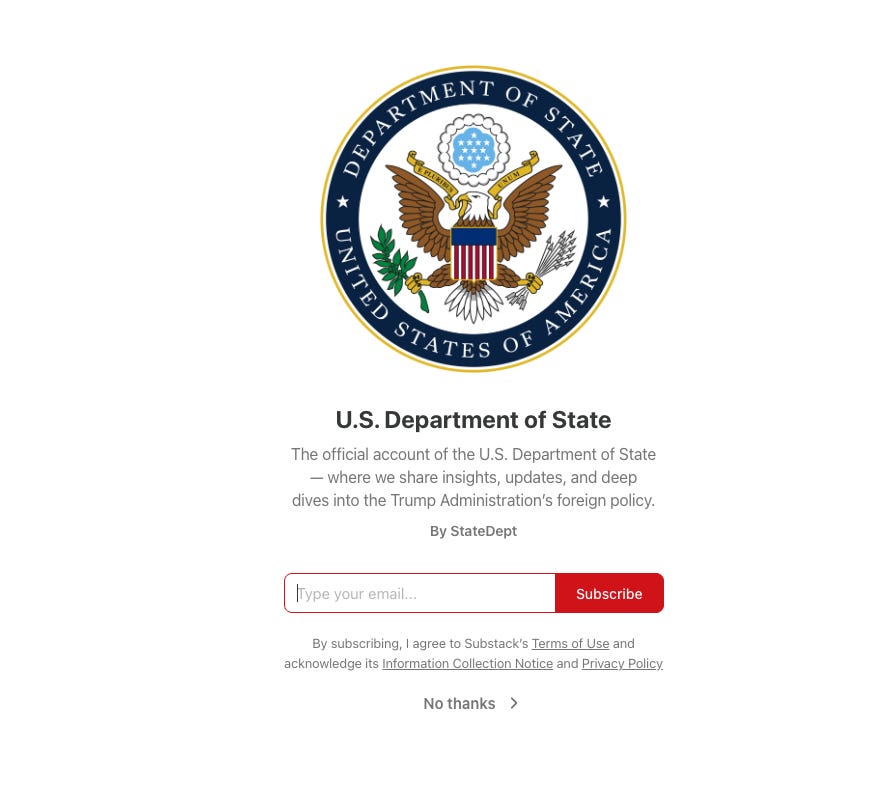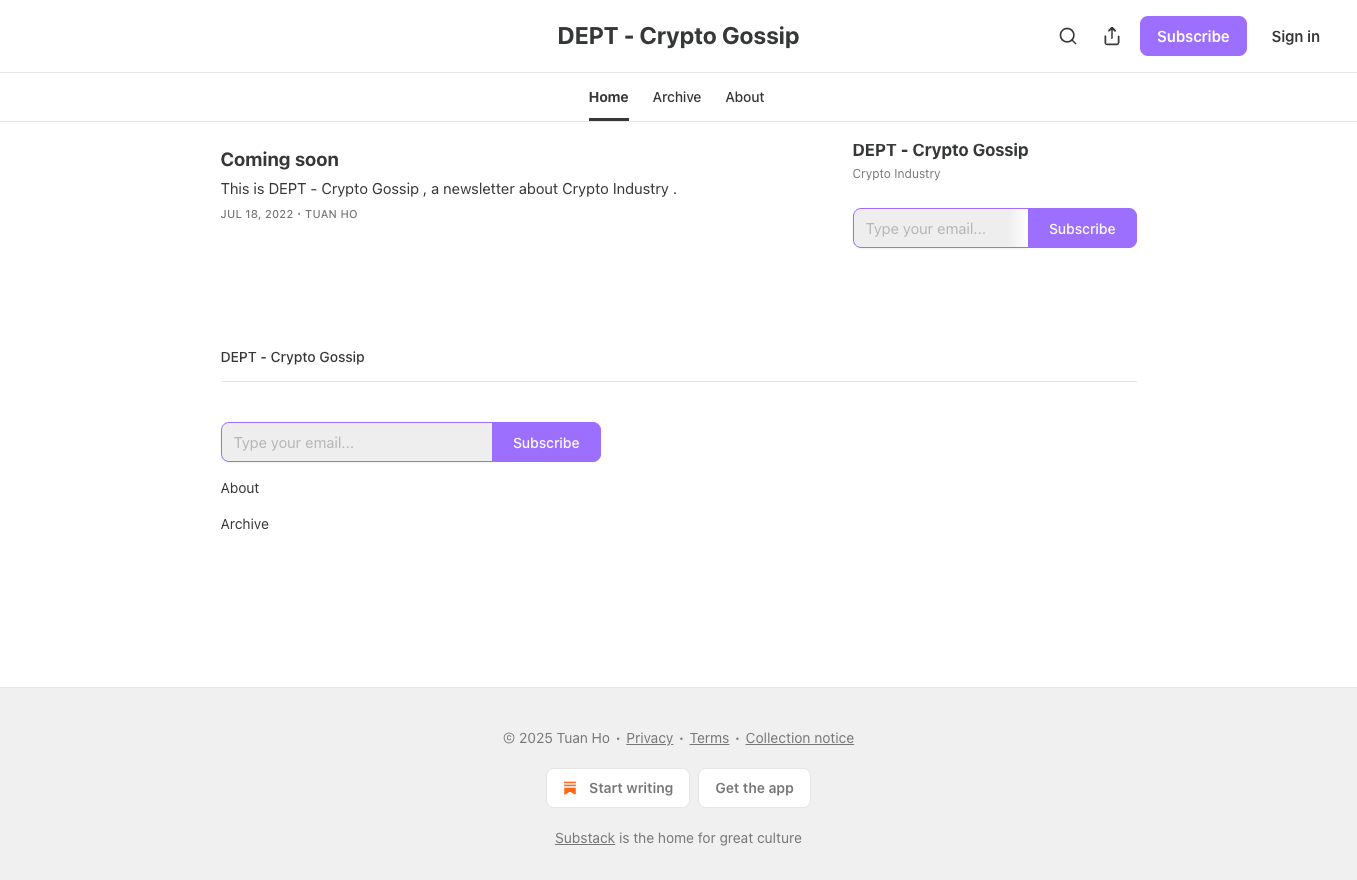Statecraft or Substack? The U.S. State Department's New Platform Deserves Scrutiny
The State Department just launched a Substack. It’s more dangerous than it sounds.
On April 22, the U.S. Department of State announced the launch of a Substack during their formal press briefing. Not as an individual. Not as a side project. As an official communications platform for policy updates and opinion content, blended together under the State Department's seal.
This wasn’t a quiet experiment in modernization. It was rolled out under the “America First” initiative and represents a strategic shift in how the federal government communicates, one that bypasses traditional channels, evades press scrutiny, and raises serious questions about transparency, accountability, and intent.

The department already operates a full communications infrastructure through state.gov, with press channels, public briefings, and direct distribution. It doesn’t need more reach. It already has it.
The move to Substack isn’t about audience growth, it’s about control. It allows the Department to bypass both the press and the constraints of official government platforms, enabling more direct, less regulated, and potentially less accountable communication with the public.
This isn't just unusual. It strategic. And dangerous. And it demands public attention and scrutiny.
A Digital Misstep That Speaks Volumes
The announcement came via spokesperson Tammy Bruce, who cited the Substack URL aloud: "state-d-e-p-t.substack.com." The problem? That phrase, when transcribed, became a hyperlink to dept.substack.com, a domain owned by someone entirely unaffiliated with the government, running a crypto gossip blog.

No one verified the link before publishing it on the official State Department site and the press briefing email. No redirect safeguards. No correction issued. The situation could have been much worse if a malicious actor had claimed or hijacked that subdomain, potentially resulting in spoofed diplomatic messages, spear phishing campaigns, malware distribution, deepfake threats, data harvesting, or manipulated statements attributed to U.S. officials.
This is precisely the kind of vulnerability that foreign adversaries look to exploit.

Why Substack? Why Now?
The US Department of State has outlined that its Substack will be used to share:
Official updates and foreign policy briefings
Opinion pieces and personal commentary from Secretary Rubio and other personnel
Explanations around departmental restructuring under the "America First" framework
This merging of personal perspective with institutional authority under one banner breaks with normal protocol and violates best practices for government communication. It deliberately blurs the lines between what's official policy, what's political, and what falls under public record laws.
The U.S. Supreme Court and constitutional scholars have repeatedly warned that blending personal views with official statements creates legal ambiguity. Justice Amy Coney Barrett herself described these "mixed-use" platforms as "unwise," in a 2024 ruling, precisely because they blur the lines between institutional authority and personal expression.
And yet, the US Department of State is doing exactly that.
Strategic Shift, or Just a New Platform?
The Substack launch wasn't announced in isolation. It came during the same briefing that outlined a major reorganization of the US Department of State under the 'America First' initiative. This restructuring includes consolidating or eliminating key offices focused on human rights, global justice, and foreign propaganda and disinformation, including:
The Under Secretary for Civilian Security
The Office of Global Criminal Justice
The Global Engagement Center (GEC)
These changes signal a retreat from longstanding diplomatic priorities like promoting democracy, defending human rights, and countering authoritarian propaganda.
The elimination of the GEC is particularly troubling, as it leaves a gap in America's defense against foreign disinformation campaigns with no clear replacement announced. It suggests an intentional weakening of U.S. defenses in the broader landscape of information warfare.
In this context, the Substack isn't merely a new communications channel - it's part of a larger strategy to bypass traditional constraints. One that reduces friction, bypasses oversight, and consolidates narrative control under the official seal.
This approach gives federal leadership a direct-to-inbox tool for blending government policy with political messaging, without the layers of accountability, regulation, or public record access that exist in traditional channels. It creates space for lengthy opinion pieces, narrative driven justifications, and language that might not withstand the scrutiny of conventional government communications.
The State Department can now bypass both the traditional press and the limitations of government platforms. This enables direct, unmediated communication with the public, greater narrative control, and content sharing that raises profound questions about transparency, accountability, and the evolving relationship between government, media, and the public.
This approach also reflects a broader pattern. In recent years, state-level entities like the Ohio Senate and Florida’s health agency have blurred the lines between official communications and partisan messaging. The Trump-aligned Project 2025 framework explicitly calls for restructuring public-facing agencies to allow more centralized narrative control.
Public Information Through Private Gateways?
Substack wasn’t designed for civic transparency. It was built for creators and monetization. Writers can put content behind paywalls, restrict access to comments, and track subscriber behavior down to the IP address.
To date, the State Department hasn’t paywalled anything. But the infrastructure exists, and that alone raises questions about equal access to government communications. Will future briefings or policy commentary become tiered content? Will access to public information depend on payment or the willingness to hand over personal data?
Even the possibility violates long-standing norms of equal access to government information.
Could Subscription Become Surveillance?
This brings us to another point that is even more concerning: when the sender is a federal agency, especially under this administration, your interaction becomes data. Substack logs your email, location, IP, and activity, creating a potential data trail that could be exploited, even if not by the agency itself.
Substack's data collection isn't unusual by platform standards. But when the author is a federal agency under this administration, that data becomes something else entirely: a trackable record of political engagement tied directly to your identity.
What makes this particularly risky is not just who’s collecting it, but what it could be combined with.
Given the federal government’s ongoing struggles with cybersecurity and exposed databases, the potential for that data to be linked, leaked, or used for profiling isn’t far-fetched. And in a climate where AI tools are increasingly used for surveillance, metadata is political.
Over 150 federal database servers are currently exposed to the internet, many containing highly sensitive personal data like Social Security numbers, tax records, and medical information. This includes servers tied to agencies such as the Departments of Energy, Education, and Defense.
If you’ve ever used the same email address to subscribe to official government updates and to access federal services, like filing taxes, applying for student loans, or using healthcare.gov, attackers or third parties could merge those data sources to build a detailed political and personal profile. That’s not hypothetical. It’s how data enrichment and profiling already happen through data brokers.
This puts Substack users, especially those who subscribe to politically sensitive content, in a uniquely vulnerable position. Your Substack engagement is tied to what you read, what you write, and which newsletters you follow. And this platform is widely known for hosting progressive and anti-Trump content.
Quick PSA: Use a Burner Email
If you’re thinking about subscribing to the State Department Substack, or any government-affiliated Substack launched under this administration, use a burner email and maybe use a VPN. It’s not that Substack is uniquely invasive; their data practices are pretty standard compared to other platforms. But what’s not standard is handing over your IP address, reading history, and your Substack profile (which might include subscriptions critical of the Trump administration or federal government) to a system that increasingly lacks independent oversight. In this climate, it’s just smart to keep your digital footprint separate from your political curiosity.
What the Public Deserves
This moment also exposes just how unprepared our policies are for the digital tools now being used, and misused, by the federal government. The systemic gaps in digital communication oversight have only widened under the current administration. And while the need for reform is obvious, the gap between what’s needed and what’s politically possible is wide.
That doesn’t make the problem less urgent. It just means the responsibility of vigilance falls to the public. Naming the risks and documenting the erosion is a necessary start.
And the public still has every right to continue demanding transparency, accountability, and responsibility from federal agencies. Some examples of what that should look like:
Clear disclaimers separating personal views from official policy
Distinct labeling for opinion pieces versus formal updates
Unrestricted, free public access to government communications
Transparent platform and data practices
Independent oversight for all new channels of public communication
Bottom Line
This isn’t modernization. It’s consolidation. And for those not paying attention, it’ll look normal fast. That’s the play.
If this resonated with you, share it, talk about it, and subscribe to stay connected.
Support the people and organizations still holding the line, because what happens now will shape our information systems, and our democracy, for decades.


Ugh. I went over to have a look. Big mistake. It's as bad as I thought it would be, and the comments are even worse. No, I didn't join for the reasons people have said here--don't give them our info.
Best to just stay away.
They're not going to propagandize there any more than they do anywhere else. We're not missing anything.
I also noticed that there isn’t a way to mute or block their account.